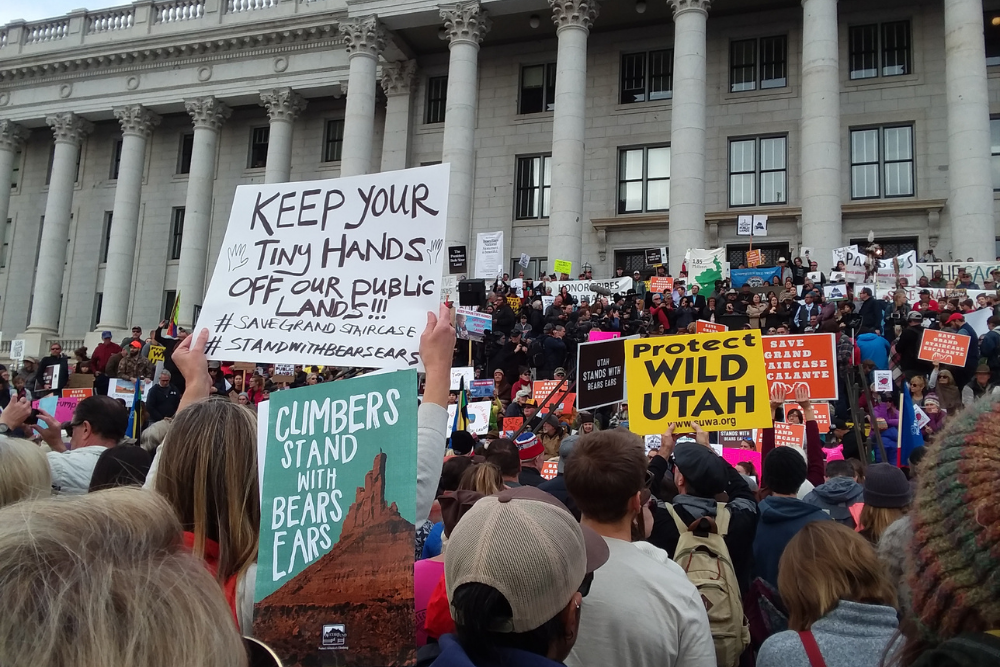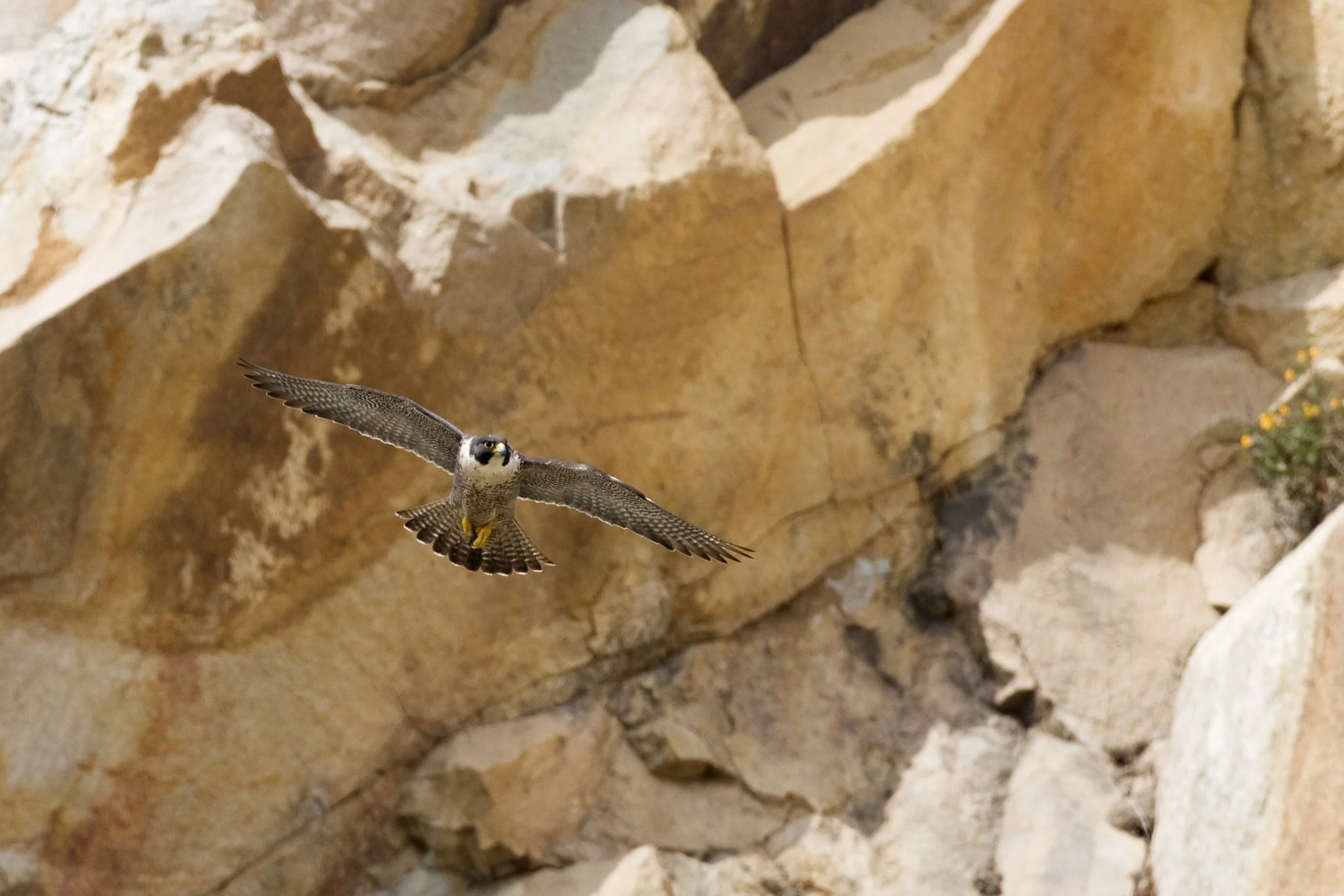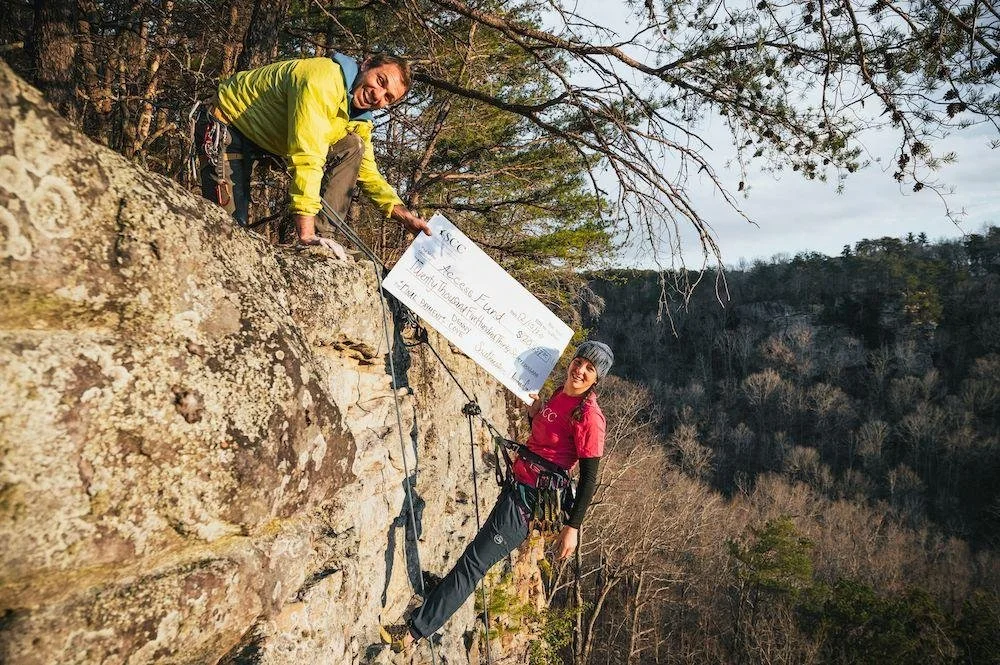As Access Fund wraps up its 30th year, you’d forgive many of its members and supporters for having a sense of déjà vu.
In California, for example, Joshua Tree National Park is attempting to upend the status quo that bolts and other fixed anchors are fundamentally allowed in Wilderness areas (with restrictions as appropriate), and instead, it’s proposing a new standard that anchors are prohibited by default.
This fight is not new. In fact, this fight is perhaps one of Access Fund’s oldest, reaching a crisis in the late ’90s, and the organization’s repeated success at protecting climbing in the Wilderness counts as one of its greatest victories.
The fight for climbing as a legitimate use of the land is not new. Much remains the same—and yet, so much is different.
At the same time—and just a few hours drive from Joshua Tree—another familiar fight is brewing. At Red Rocks outside of Las Vegas, land managers are proposing to regulate climbers and other recreationists who want to visit Calico Basin by building a gated entrance station, which would allow them to limit both the numbers of visitors and the hours they can visit. While the proposed plan would still allow for regulated climbing, the building of a literal gate that would be locked evokes a visceral reaction from an organization whose mission, enshrined in its iconic logo, has always come down to keeping gates open.
So it would seem that three decades after Access Fund was founded in the midst of an epidemic of land managers threatening to close crags to climbing, much remains the same.
And yet, so much is different.
Red Rock Canyon National Conservation Area recently implemented a permanent permit system. Ancestral lands of Southern Paiute and Western Shoshone. © Irene Yee
“Land managers are underresourced and overwhelmed,” Access Fund Executive Director Chris Winter says. “And then as now, the easy answer is just to say no—to close the gate. But it’s not as simple as yes or no anymore. We have to be creative in the face of these challenges.”
Winter is steering Access Fund forward with what he sees as climbers’ twin core values in mind.
“We treasure sustainable access to climbing areas, and we care deeply for the land,” he says. “As we think through the future, it’s going to become increasingly difficult to balance both of these values for the climbing community because there are so many other threats to the land. We have to champion not just access, but sustainable access and conservation.”
Freaks no More
Access Fund was founded on the heels of the climbing revolution of the 1980s. Bolts were going in, opening up previously unclimbable cliffs, and many land managers were confronted with a whole new user group that seemed, well, strange. Lycra-clad climbers of the day, who identified as being in the “out” group and relished surviving on the societal fringe, were not what many land managers were used to.
“Land managers looked at many of us as freaks,” Winter says. “But Access Fund committed itself to representing all climbers in all forms of climbing.”
Indian Creek, Utah. Ancestral lands of Navajo, Ute, Ute Mountain, Hopi and Zuni. © Andrew Burr
In the face of the new and unknown, closures began popping up seemingly everywhere.
“Land managers were not used to dealing with climbers; climbers had been invisible to them,” says legendary climber Rick Accomazzo, one of Access Fund’s founders. “In some places, when land managers were confronted with their first sport routes, they chose to manage by closing. That was a typical response—the easiest way to manage climber impacts was to just ban climbing.”
The central work of Access Fund, then, became to establish climbing as a legitimate use of the land. Access Fund staff worked tirelessly to educate land managers, to build trust, and to advocate for the right of all climbers to recreate on our public lands alongside hikers, bikers, and other recreationists, as well as to calm fears related to liability at privately owned crags. And Access Fund has been incredibly successful.
The central work of Access Fund in its early years was establishing climbing as a legitimate use of the land. Through tireless work educating land managers, building trust, and advocating for the right to recreate on public lands, Access Fund has been incredibly successful.
Today, Access Fund and the local climbing organizations it supports have strong, long-term ties with land management agencies across the U.S. as well as on Capitol Hill. The organization’s influence and standing was showcased earlier this year when Winter was invited to the White House to celebrate the restoration of Bears Ears National Monument.
“We are no longer regarded as aliens on public lands—as some curiosity,” says Zachary Lesch-Huie, Access Fund vice president of programs & acquisitions. “We are a normalized recreational use. We now get to engage with land managers and community partners who are comfortable with us and who know climbing already, and the difference that makes is profound.”
Grappling with Sheer Numbers
Today, access issues don’t usually boil down to whether climbing should simply be allowed. Instead, it’s often about the impacts of our use. As we all know by now, the number of climbers has soared, and more and more of us are discovering the magic of climbing outside. The sheer number of climbers at the crags magnifies our impacts—from trampling vegetation beneath boulders and causing erosion to leaving behind waste, both human and otherwise.
Climbing’s growth also mirrors a larger increase in outdoor recreation. There are more hikers, more campers, more bikers—more recreationists of all kinds. This wave of people is swamping public lands and their collective impacts contribute to a host of new access issues for our community.
A climber on a bolted face route in Joshua Tree National Park. Ancestral lands of the Serrano and Western Shoshone
Take the examples at Joshua Tree and Red Rocks. For the last two decades, Joshua Tree National Park allowed for the one-to-one replacement of old bolts with a hand drill in Wilderness areas without a permit. The park is now considering a new climbing management plan that would regard bolts as fundamentally prohibited in the Wilderness. Hundreds of routes could be removed, and the park may impose a tedious and uncertain permitting process to allow for the replacement of aging bolts—changes that could have profound safety implications for climbing in Wilderness areas across the country.
Why the change now? The park’s stated need for a new climbing management plan specifically calls out the doubling of park visitors. About 1.2 million people visited Joshua Tree in 2000; last year, the number topped 3 million for the first time. While most visitors are not climbers (we make up about 20% of the total number), the collective impacts of recreation and visitation of all types include more social trails and trampling of fragile desert crusts.
Climbing’s growth also mirrors a larger increase in outdoor recreation. There are more hikers, more campers, more bikers—more recreationists of all kinds—whose collective impacts force land managers to balance access with conservation.
At Calico Basin, the increase is even more stark. Todd Swain’s 1993 Red Rocks guidebook describes Calico Basin as an area mostly ignored by visiting climbers except for a few “curious souls.” These days, there are more than a few. According to the Bureau of Land Management, about 2,800 people visited Calico Basin in 2012, the first year numbers were available. By 2020, visitation had ballooned to more than 730,000—a mind-boggling 260-fold increase. As with Joshua Tree, these aren’t all climbers (Calico Basin is now the venue for three to six weddings a day in the nonsummer months, for example), but the collective impacts are driving the need for a new management strategy that threatens climbing access.
Climbers are not blind to the impacts of increased use at our favorite climbing areas. In fact, most climbers are deeply committed to protecting the places they climb and mitigating their impacts on natural and cultural resources. This mitigation can take many forms, including trail work and education, but it can also reasonably include some regulation.
Most climbers are deeply committed to protecting the places they climb and mitigating their impacts on natural and cultural resources—mitigation that includes trail work and education, but it can also reasonably include some regulation.
“Permits, reservations, and fees—it’s not as simple as saying they’re all good or they’re all bad,” Winter says. “The devil is always in the details. These issues are becoming much more complex, and it requires an organization like Access Fund to navigate these murky waters. Climbers need a seat at the table where decisions are made, and we need to have smart, creative solutions that protect the resource, focus on equity, and provide all people an opportunity to get out there and experience these places.”
Winter points to raptor closures as an example. When land managers first realized that climbing in some areas could harm fledglings, the instinct was to close climbing permanently, Winter says. But the climbing community sought a compromise that closed climbing during just the sensitive parts of the year while reopening the cliffs at other times. It was a win-win: The birds were protected and climbing became the norm on public lands.
Access Fund continues to approach other proposed limitations on climbing with a similar mindset of finding workable solutions that support sustainable and equitable access.
“Good management can almost always afford to include some amount of climbing,” Lesch-Huie says. “But good climbing policy is not climbing at all costs. Land managers know that Access Fund can balance other values.”
Moving Beyond Emergency Response
In the next three decades, as in the last three, Access Fund will continue to bring its considerable expertise to these individual access emergencies as they pop up across the country. But in parallel, the organization is now focused on operating beyond the immediate threats to individual crags and is working to head off access threats before they arise.
“We’ve been in the emergency response department for a long time,” says Zachary Lesch-Huie. “Now we are working to add capacity to our community planning department; we are able to be forward-looking and get ahead of these problems.”
Former SCC Executive Director, Andrea Hassler passes a giant check to Access Fund Vice President of Programs and Acquisitions Zachary Lesch-Huie to signify the payoff of Denny Cove which was purchased through Access Fund's revolving Climbing Conservation Loan Program. Ancestral lands of Cherokee, Shawnee, and Yuchi. © Nathalie DuPre
The tools that Access Fund is employing to be proactive include stewardship work, local climbing organization support, land acquisitions, and climber education, along with policy work focused on big-picture national-level solutions. None of these tools are new for the organization—trail work, for example, has been a staple of Access Fund’s work since the beginning. And the first time Access Fund helped purchase a crag was in 1990, when it joined with The Trust for Public Land to buy the Peshastin Pinnacles in Washington, which had been closed by private landowners several years before.
However, now that climbing has largely been legitimized as a use of the land, Access Fund is able to dedicate more resources to these proactive efforts. For example, the organization now has professional Conservation Teams that have the skills to build sustainable climbing infrastructure, including trails and hardening belay areas. In the last year, it has also added dedicated Climbing Stewards to the staff—first in Indian Creek in the fall and starting this summer at New River Gorge—who are on-site to provide climbers with the knowledge they need to lessen their impacts on natural and cultural resources.
Parallel to applying its expertise to individual access emergencies nationwide, Access Fund is now focused on operating beyond the immediate threats to individual crags and is working to head off access threats as they arise.
Access Fund has also grown its acquisition program and leveraged its financial resources to protect dozens of at-risk crags across the country, and local climbing organizations are flourishing with Access Fund support. More than 130 now exist from Alaska to Ohio, from New Hampshire to Arizona, and just about every place in between.
Collectively, these programs and others have helped bring about a shift at Access Fund from always having to play defense to being able to go on the offense.
“We have largely legitimized climbing; now there is much larger regard for climbing as a value on the land,” says Lesch-Huie. “We are no longer always trying to convince land managers that they should make space for climbing. Now people are actually reaching out to us and saying, ‘We want climbing. How do we manage it? How do we bring it to our community?’”
Breaks Interstate Park is a prime example. Home to bulletproof sandstone á la New River Gorge, this park is on the border of southwest Virginia and Kentucky in a rural area that has suffered economically as coal mining in the region has faded. Park staff worked with Access Fund to open the cliffs to climbing in 2016 with the goal of encouraging the growth of the area’s outdoor recreation economy.
The Access Fund Conservation Team Special Projects worked on several trail reroutes over six weeks to guide climber access and avoid erosion down steep drainages at Breaks Interstate Park. Ancestral Lands of the East Cherokee, Shawandasse Tula (Shawanwaki/Shawnee), and S’atsoyaha (Yuchi).
Access Fund’s ability to step back from constant triage and response to access emergencies has also allowed it to focus on ensuring that access to new areas like Breaks is sustainable over the long term. Beyond managing the impacts of increasing use, this also means considering climbing access in the context of the great environmental challenges of our time, including climate change, resource extraction, and development pressures. These issues have the potential to affect climbing access, but even more so, they threaten the very experience of climbing. The impacts of climate change, for example, include increasing wildfires, which can scorch crags and cause long-term closures by land managers. A warming climate is also making ice climbs more ephemeral and destabilizing long-used mountaineering routes, and it is also fundamentally changing the nature of the ecosystems climbers have come to cherish.
Access Fund is exploring the role it can play in addressing these issues. It has been lobbying in support of legislation to support climate change and other environmental legislation, but a more direct action the organization is pursuing is protection of not just a particular crag, but the larger landscape surrounding the crag. This was the outcome of Access Fund’s years-long effort with its partners and allies to protect Bears Ears National Monument in Utah. Of course, the monument protects classic climbing areas, including the splitters of Indian Creek, but Access Fund was steadfast in its support for protecting the entire landscape, which includes winding canyons, breathtaking desert vistas, and an untold number of cultural artifacts. Safeguarding large swaths of land around climbing areas protects the climbing experience, but it also promotes climate resiliency in a number of ways, including increasing the amount and variability of habitat available to climate-stressed plants and animals.
Protestors gather at Utah capitol to push back against the reduction of Bears Ears and Grand Staircase-Escalante national monuments.
Access Fund's ability to step back from constant triage and response to access emergencies has also allowed it to focus on ensuring that access to new areas is sustainable over the long term.
“Climate change is forcing land managers to deal with pretty rapid changes, and that increases the risk of restrictions on access,” Winter says. “We have an opportunity for climbers to partner and help land managers and take care of the places we love.”
In some ways, today’s “helping and partnering” with land managers is much more complex than 30 years ago. It includes educating our own on how to recreate on public lands in a way that still protects natural and cultural artifacts. It includes coming up with creative ways to address the impacts of our numbers and helping land managers make the reservation and permitting systems they propose as fair as possible for climbers and all user groups. It includes tracking complex national public lands and climate change bills and navigating myriad sensitive issues to build alliances. But at its core, climbers helping land managers protect the places we love brings Access Fund right back to the beginning 30 years ago.
“It’s still the same,” Accomazzo says. “There are still excited volunteers who love their local crag and who will go to work to protect it when it’s threatened. That’s always been true, and it’s still true today.”







